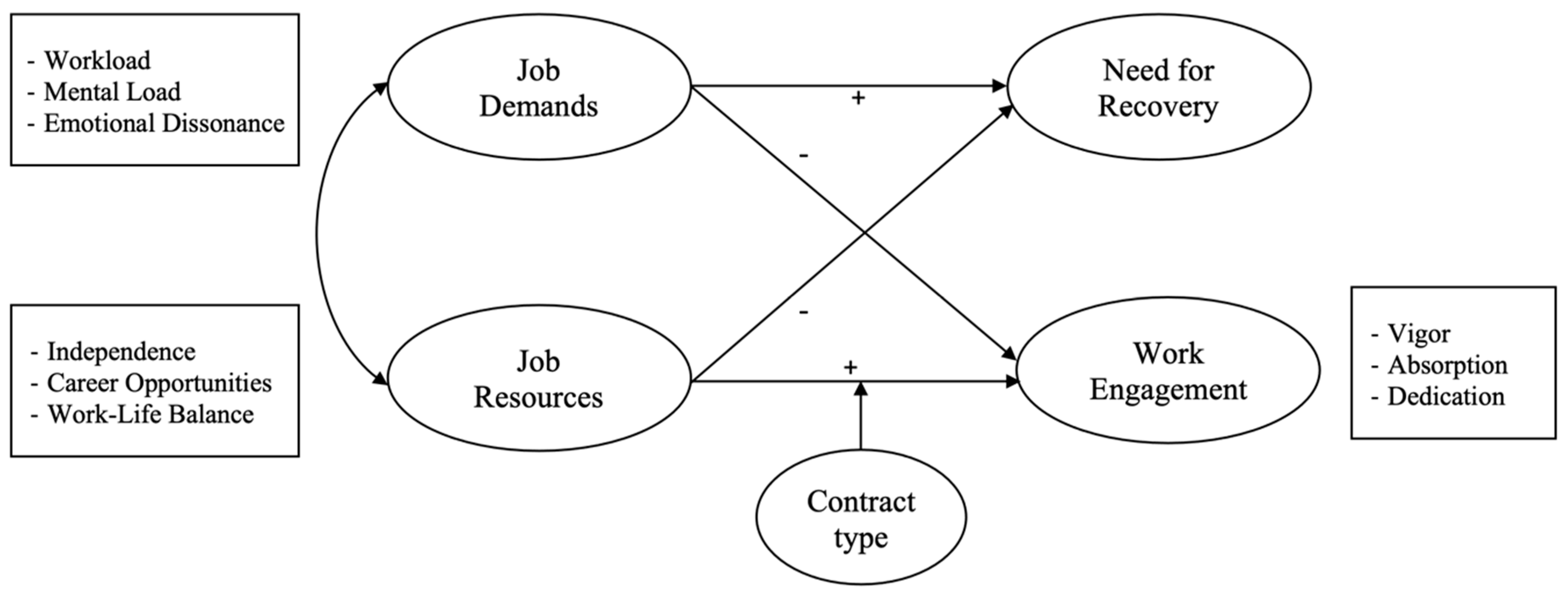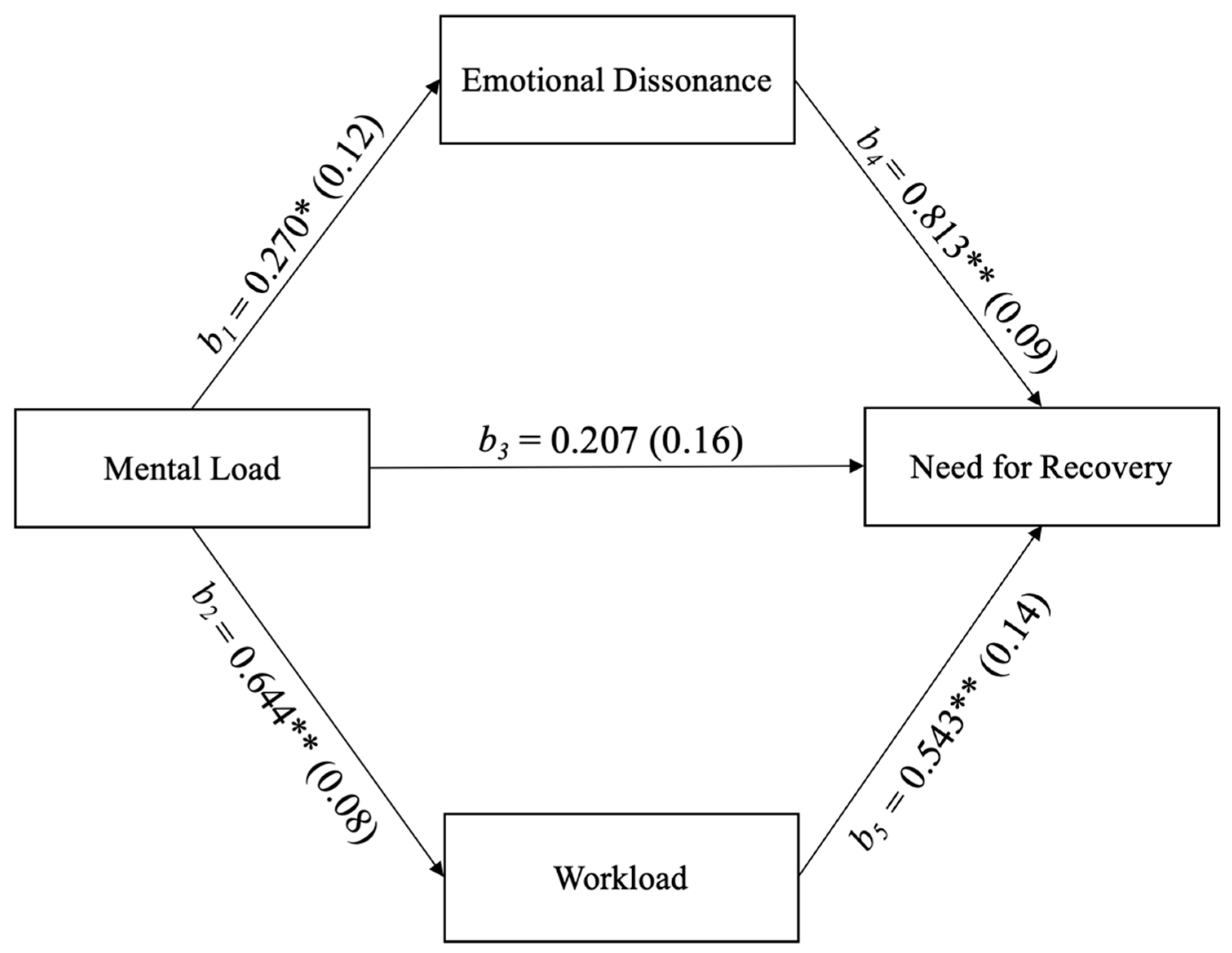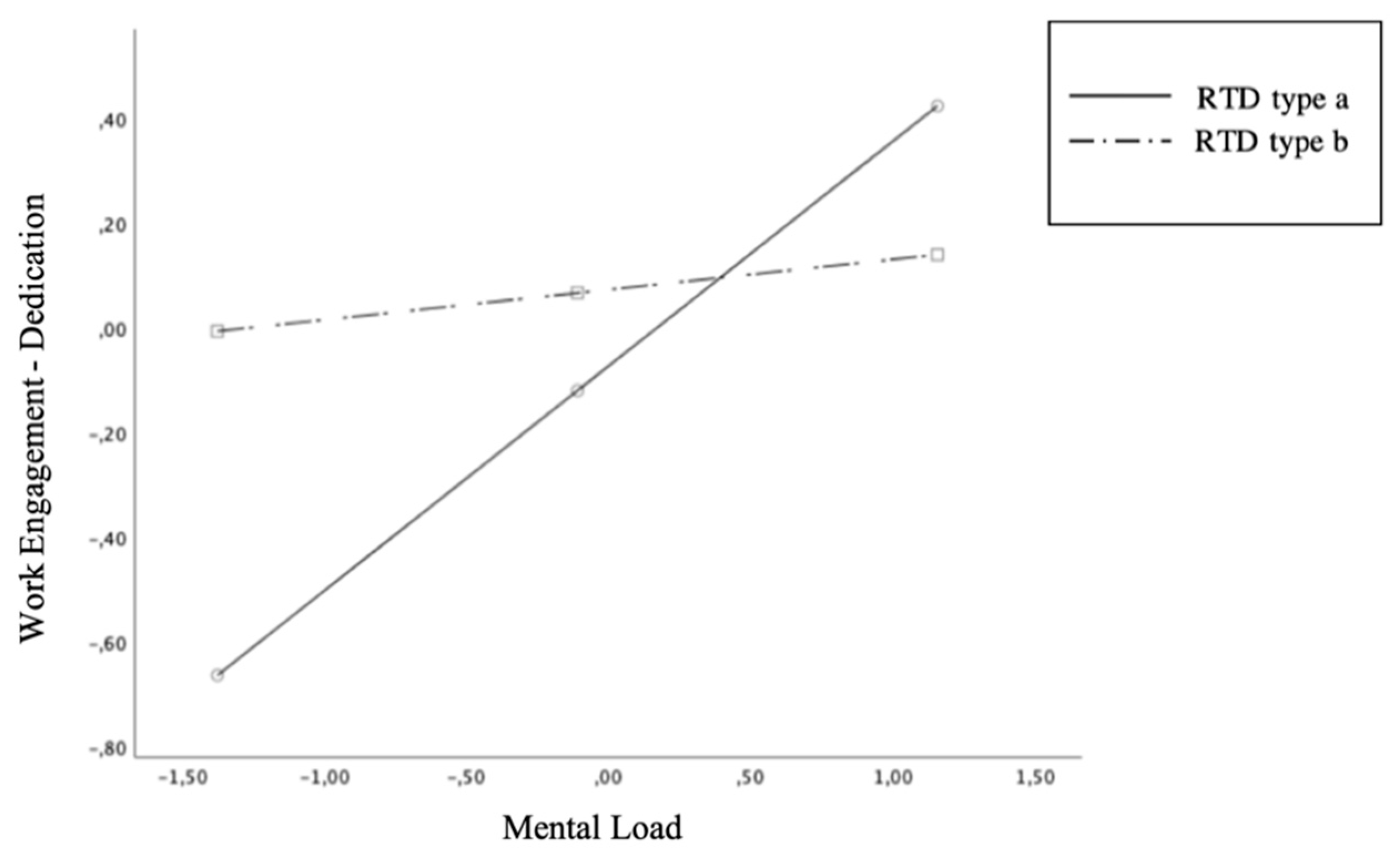The Effect of Emotional Dissonance and Mental Load on Need for Recovery and Work Engagement among Italian Fixed-Term Researchers
Abstract
1. Introduction
1.1. Job Demands–Resources Model
1.2. Job Demands and Resources among Academics
1.3. Need for Recovery and Work Engagement
1.4. Hypotheses
2. Materials and Methods
2.1. Sample
2.2. Measures
2.3. Data Analysis
3. Results
4. Discussion
Limitations and Future Research
5. Conclusions
Author Contributions
Funding
Institutional Review Board Statement
Informed Consent Statement
Data Availability Statement
Acknowledgments
Conflicts of Interest
References
- Gillespie, N.A.; Walsh, M.; Winefield, A.H.; Dua, J.; Stough, C. Occupational stress in universities: Staff perceptions of the causes, consequences and moderators of stress. Work Stress 2001, 15, 53–72. [Google Scholar] [CrossRef]
- Winter, R.; Sarros, J. The academic work environment in Australian universities: A motivating place to work? High. Educ. Res. Dev. 2002, 21, 243–258. [Google Scholar] [CrossRef]
- Winefield, A.H.; Gillespie, N.; Stough, C.; Dua, J.; Haparachchi, J.; Boyd, C. Occupational stress in Australian university staff: Results from a national survey. Int. J. Stress Manag. 2003, 10, 51–63. [Google Scholar] [CrossRef]
- Tytherleigh, M.Y.; Webb, C.; Cooper, C.L.; Ricketts, C. Occupational stress in UK higher education institutions: A comparative study of all staff categories. High. Educ. Res. Dev. 2005, 24, 41–61. [Google Scholar] [CrossRef]
- Kinman, G.; Jones, F. A life beyond work? Job demands, work-life balance and wellbeing in UK academics. J. Human Behav. Soc. Environ. 2008, 17, 41–60. [Google Scholar] [CrossRef]
- Boyd, C.M.; Bakker, A.B.; Pignata, S.; Winefield, A.H.; Gillespie, N.A. A longitudinal test of the job demands-resources model among Australian university academics. Appl. Psychol. 2011, 60, 112–140. [Google Scholar] [CrossRef]
- Barkhuizen, N.; Rothmann, S.; Vijver, F.J. Burnout and work engagement of academics in higher education institutions: Effects of dispositional optimism. Stress Health 2014, 30, 322–332. [Google Scholar] [CrossRef]
- Shin, J.C.; Jung, J. Academics job satisfaction and job stress across countries in the changing academic environments. High. Educ. 2014, 67, 603–620. [Google Scholar] [CrossRef]
- Hochschild, A.R. The Managed Heart: The Commercialization of Human Feeling; University of California Press: Berkeley, CA, USA, 1983. [Google Scholar]
- Morris, J.A.; Feldman, D.C. The dimensions, antecedents, and consequences of emotional labor. Acad. Manag. Rev. 1996, 21, 986–1010. [Google Scholar] [CrossRef]
- Grandey, A.A. Emotional regulation in the workplace: A new way to conceptualize emotional labor. J. Occup. Health Psychol. 2000, 5, 95–110. [Google Scholar] [CrossRef]
- Demerouti, E.; Bakker, A.B.; Nachreiner, F.; Schaufeli, W.B. The job demands–resources model of burnout. J. Appl. Psychol. 2001, 86, 499–512. [Google Scholar] [CrossRef] [PubMed]
- Bakker, A.B.; Demerouti, E. The job demands–resources model: State of the art. J. Manag. Psychol. 2007, 22, 309–328. [Google Scholar] [CrossRef]
- Bakker, A.B.; Demerouti, E. Job demands–resources theory: Taking stock and looking forward. J. Occup. Health Psychol. 2017, 22, 273–285. [Google Scholar] [CrossRef] [PubMed]
- Diestel, S.; Schmidt, K. Interactive effects of emotional dissonance and self-control demands on burnout, anxiety, and absenteeism. J. Vocat. Behav. 2010, 77, 412–424. [Google Scholar] [CrossRef]
- Hakanen, J.; Bakker, A.B.; Schaufeli, W.B. Burnout and work engagement among teachers. J. School Psychol. 2006, 43, 495–513. [Google Scholar] [CrossRef]
- Skaalvik, E.M.; Skaalvik, S. Teacher job satisfaction and motivation to leave the teaching profession: Relations with school context, feeling of belonging, and emotional exhaustion. Teach. Teach. Educ. 2011, 27, 1029–1038. [Google Scholar] [CrossRef]
- Dicke, T.; Stebner, F.; Linninger, C.; Kunter, M.; Leutner, D. A longitudinal study of teachers’ occupational well-being: Applying the job demands-resources model. J. Occup. Health Psychol. 2018, 23, 262–277. [Google Scholar] [CrossRef]
- Bakker, A.B.; Demerouti, E.; Euwema, M.C. Job resources buffer the impact of job demands on burnout. J. Occup. Health Psychol. 2005, 10, 170–180. [Google Scholar] [CrossRef]
- Demerouti, E.; Bakker, A.B.; Xanthopoulou, D. Job demands-resources theory and the role of individual cognitive and behavioral strategies. In The Fun and Frustration of Modern Working Life: Contributions from an Occupational Health Psychology Perspective; Taris, T., Peeters, M., De Witte, H., Eds.; Pelckmans Pro: Antwerp, Belgium, 2019; pp. 94–104. [Google Scholar]
- Searle, B.; Lee, L. Proactive coping as a personal resource in the expanded job demands–resources model. Int. J. Stress Manag. 2015, 22, 46–69. [Google Scholar] [CrossRef]
- Bakker, A.B.; Demerouti, E. Multiple Levels in Job Demands-Resources Theory: Implications for employee well-being and performance. In Handbook of Well-Being; Diener, E., Oishi, S., Tay, L., Eds.; Noba Scholar: Salt Lake City, UT, USA, 2018. [Google Scholar]
- Kenny, J. Re-empowering academics in a corporate culture: An exploration of workload and performativity in a university. High. Educ. 2018, 75, 365–380. [Google Scholar] [CrossRef]
- Gaillard, A.W.K.; Wientjes, C.J.E. Mental load and work stress as two types of energy mobilization. Work Stress 1994, 8, 141–152. [Google Scholar] [CrossRef]
- Demerouti, E.; Taris, T.W.; Bakker, A.B. Need for recovery, home-work interference and performance: Is lack of concentration the link? J. Vocat. Behav. 2007, 71, 204–220. [Google Scholar] [CrossRef]
- Cinaz, B.; Arnrich, B.; La Marca, R.; Troster, G. Monitoring of mental workload levels during an everyday life office-work scenario. Pers. Ubiquitous Comput. 2013, 17, 229–239. [Google Scholar] [CrossRef]
- Crawford, E.R.; LePine, J.A.; Rich, B.L. Linking job demands and resources to employee engagement and burnout: A theoretical extension and meta-analytic test. J. Appl. Psychol. 2010, 95, 834–848. [Google Scholar] [CrossRef] [PubMed]
- Watts, J.; Robertson, N. Burnout in university teaching staff: A systematic literature review. Educ. Res. 2011, 53, 33–50. [Google Scholar] [CrossRef]
- Brotheridge, C.M.; Lee, R.T. Development and validation of the Emotional Labour Scale. J. Occup. Organ. Psychol. 2003, 76, 365–379. [Google Scholar] [CrossRef]
- Brotheridge, C.M.; Grandey, A.A. Emotional labor and burnout: Comparing two perspectives of “people work”. J. Vocat. Behav. 2002, 60, 17–39. [Google Scholar] [CrossRef]
- Taxer, J.L.; Frenzel, A.C. Inauthentic expressions of enthusiasm: Exploring the cost of emotional dissonance in teachers. Learn. Instr. 2018, 53, 74–88. [Google Scholar] [CrossRef]
- Zapf, D. Emotion work and psychological well-being. A review of the literature and some conceptual considerations. Hum. Resour. Manag. Rev. 2002, 12, 237–268. [Google Scholar] [CrossRef]
- Heuven, E.; Bakker, A.B. Emotional dissonance and burnout among cabin attendants. Eur. J. Work Organ. Psychol. 2003, 12, 81–100. [Google Scholar] [CrossRef]
- Jacobs, J.A.; Winslow, W.E. Overworked faculty: Job stresses and family demands. Ann. Am. Acad. Pol. Soc. Sci. 2004, 596, 104–129. [Google Scholar] [CrossRef]
- Karatepe, O.M. Do job resources moderate the effect of emotional dissonance on burnout? A study in the city of Ankara, Turkey. Int. J. Contemp. Hosp. Manag. 2011, 23, 44–65. [Google Scholar] [CrossRef]
- Simbula, S.; Mazzetti, G.; Guglielmi, D. A three-wave study on the reciprocal relationships between emotional dissonance, need for recovery, and exhaustion. Sustainability 2019, 11, 5183. [Google Scholar] [CrossRef]
- Sonnentag, S.; Kuttler, I.; Fritz, C. Job stressors, emotional exhaustion, and need for recovery: A multi-source study on the benefits of psychological detachment. J. Vocat. Behav. 2010, 76, 355–365. [Google Scholar] [CrossRef]
- Sonnentag, S.; Zijlstra, F.R.H. Job characteristics and off-job activities as predictors of need for recovery, well-being, and fatigue. J. Appl. Psychol. 2006, 91, 330–350. [Google Scholar] [CrossRef] [PubMed]
- Nieuwenhuijsen, K.; Sluiter, J.K.; Dewa, C.S. Need for recovery as an early sign of depression risk in a working population. J. Occup. Environ. Med. 2016, 58, 350–354. [Google Scholar] [CrossRef] [PubMed]
- Kinnunen, U.; Mauno, S.; Siltaloppi, M. Job insecurity, recovery and well-being at work: Recovery experiences as moderators. Econ. Ind. Democracy 2010, 31, 179–194. [Google Scholar] [CrossRef]
- Xanthopoulou, D.; Bakker, A.B.; Oerlemans, W.G.; Koszucka, M. Need for recovery after emotional labor: Differential effects of daily deep and surface acting. J. Organ. Behav. 2018, 39, 481–494. [Google Scholar] [CrossRef]
- Schaufeli, W.B.; Bakker, A.B. Job demands, job resources, and their relationship with burnout and engagement: A multi-sample study. J. Organ. Behav. 2004, 25, 293–315. [Google Scholar] [CrossRef]
- Mauno, S.; Kinnunen, U.; Ruokolainen, M. Job demands and resources as antecedents of work engagement: A longitudinal study. J. Vocat. Behav. 2007, 70, 149–171. [Google Scholar] [CrossRef]
- Xanthopoulou, D.; Bakker, A.B.; Demerouti, E.; Schaufeli, W.B. The role of personal resources in the job demands-resources model. Int. J. Stress Manag. 2007, 14, 121–141. [Google Scholar] [CrossRef]
- Cavanaugh, M.A.; Boswell, W.R.; Roehling, M.V.; Boudreau, J.W. An empirical examination of self-reported work stress among U.S. managers. J. Appl. Psychol. 2000, 85, 65–74. [Google Scholar] [CrossRef] [PubMed]
- Xanthopoulou, D.; Bakker, A.B.; Fischbach, A. Work engagement among employees facing emotional demands. J. Pers. Psychol. 2013, 12, 74–84. [Google Scholar] [CrossRef]
- Balducci, C.; Fraccaroli, F.; Schaufeli, W.B. Psychometric properties of the Italian version of the Utrecht Work Engagement Scale (UWES-9). Eur. J. Psychol. Assess. 2010, 26, 143–149. [Google Scholar] [CrossRef]
- Pace, F.; Foddai, E.; Lo Cascio, V.; Passalacqua, C.; Zanca, M.; Civilleri, A. Using the Questionnaire on Experience and Assessment of Work with the Italian population. In Proceedings of the 9th Conference of the European Academy of Occupational Health Psychology, Rome, Italy, 29–31 March 2010; Nottingham University Press: Nottingham, UK, 2010; pp. 407–408. [Google Scholar]
- Hu, L.; Bentler, P.M. Cutoff criteria for fit indexes in covariance structure analysis: Conventional criteria versus new alternatives. Struct. Equ. Modeling J. 1999, 6, 1–55. [Google Scholar] [CrossRef]
- Tunguz, S. In the eye of the beholder: Emotional labor in academia varies with tenure and gender. Stud. High. Educ. 2016, 41, 3–20. [Google Scholar] [CrossRef]
- Di Stefano, G.; Gaudiino, M. Workaholism and work engagement: How are they similar? How are they different? A systematic review and meta-analysis. Eur. J. Work Organ. Psychol. 2019, 28, 329–347. [Google Scholar] [CrossRef]



| Variable | Mean (sd) | 1 | 2 | 3 | 4 | 5 | 6 | 7 | 8 | 9 | 10 |
|---|---|---|---|---|---|---|---|---|---|---|---|
| 1. Workload | 12.36 (2) | 1 | |||||||||
| 2. Mental Load | 14.17 (1.6) | 0.509 ** | 1 | ||||||||
| 3. Emotional Dissonance | 7.34 (2.5) | 0.482 ** | 0.166 * | 1 | |||||||
| 4. Independence | 15.13 (2.7) | −0.369 ** | −0.062 | −0.530 ** | 1 | ||||||
| 5. Career Opportunities | 7.78 (2.2) | −0.167 * | 0.022 | −0.322 ** | 0.370 ** | 1 | |||||
| 6. Work-Life Balance | 7.55 (1.9) | −0.433 ** | −0.248 ** | −0.474 ** | 0.443 ** | 0.262 ** | 1 | ||||
| 7. Need for Recovery | 14.9 (4) | 0.566 ** | 0.308 ** | 0.668 ** | −0.510 ** | −0.231 ** | −0.526 ** | 1 | |||
| 8. Work Eng—Vigor | 11.75 (3.3) | −0.170 * | 0.101 | −0.506 ** | 0.525 ** | 0.476 ** | 0.327 ** | −0.411 ** | 1 | ||
| 9. Work Eng—Absorption | 13.13 (2.4) | 0.0233 ** | 0.461 ** | 0.053 | −0.035 | 0.083 | −0.106 | 0.137 | 0.377 ** | 1 | |
| 10. Work Eng—Dedication | 13.74 (2.9) | −0.155 | 0.232 ** | −0.385 ** | 0.412 ** | 0.368 ** | 0.235 ** | −0.307 ** | 0.807 ** | 0.480 ** | 1 |
| Predictors | Need for Recovery | |||
|---|---|---|---|---|
| R2 | ΔR2 | β | p | |
| Step 1—Control variables | 0.03 | |||
| Gender (−0.5 = male; 0.5 = female) | 0.051 | 0.354 | ||
| Tenure (−0.5 = low; 0.5 = high) | −0.183 | 0.002 | ||
| RTD type (−0.5 = a; 0.5 = b) | 0.088 | 0.135 | ||
| Step 2—Job Demands | 0.34 | 0.31 | ||
| Workload | 0.305 | 0.000 | ||
| Mental load | 0.062 | 0.334 | ||
| Step 3 | 0.56 | 0.22 | ||
| Emotional dissonance | 0.562 | 0.000 | ||
| Predictors | Vigor | Absorption | Dedication | |||||||||
|---|---|---|---|---|---|---|---|---|---|---|---|---|
| R2 | ΔR2 | β | p | R2 | ΔR2 | β | p | R2 | ΔR2 | β | p | |
| Step 1—Control variables | 0.05 | 0.00 | 0.03 | |||||||||
| Gender (−0.5 = male; 0.5 = female) | −0.037 | 0.574 | 0.006 | 0.932 | −0.006 | 0.935 | ||||||
| Tenure (−0.5 = low; 0.5 = high) | −0.079 | 0.238 | 0.015 | 0.840 | −0.090 | 0.203 | ||||||
| RTD type (−0.5 = a; 0.5 = b) | 0.020 | 0.774 | −0.016 | 0.841 | −0.021 | 0.772 | ||||||
| Step 2—Job Resources | 0.39 | 0.34 | 0.22 | 0.22 | 0.30 | 0.27 | ||||||
| Independence | 0.434 | 0.000 | −0.018 | 0.827 | 0.360 | 0.000 | ||||||
| Career opportunities | 0.295 | 0.000 | 0.078 | 0.338 | 0.224 | 0.004 | ||||||
| Mental load | 0.129 | 0.047 | 0.462 | 0.000 | 0.269 | 0.000 | ||||||
| Step 3—Interactions | 0.41 | 0.02 | 0.24 | 0.02 | 0.33 | 0.03 | ||||||
| Independence X RTD type | −0.125 | 0.079 | −0.102 | 0.206 | −0.080 | 0.287 | ||||||
| Career opportunities X RTD type | 0.013 | 0.848 | −0.009 | 0.914 | 0.034 | 0.645 | ||||||
| Mental load X RTD type | −0.070 | 0.186 | −0.087 | 0.243 | −0.171 | 0.015 | ||||||
Publisher’s Note: MDPI stays neutral with regard to jurisdictional claims in published maps and institutional affiliations. |
© 2020 by the authors. Licensee MDPI, Basel, Switzerland. This article is an open access article distributed under the terms and conditions of the Creative Commons Attribution (CC BY) license (http://creativecommons.org/licenses/by/4.0/).
Share and Cite
Pace, F.; Sciotto, G. The Effect of Emotional Dissonance and Mental Load on Need for Recovery and Work Engagement among Italian Fixed-Term Researchers. Int. J. Environ. Res. Public Health 2021, 18, 99. https://doi.org/10.3390/ijerph18010099
Pace F, Sciotto G. The Effect of Emotional Dissonance and Mental Load on Need for Recovery and Work Engagement among Italian Fixed-Term Researchers. International Journal of Environmental Research and Public Health. 2021; 18(1):99. https://doi.org/10.3390/ijerph18010099
Chicago/Turabian StylePace, Francesco, and Giulia Sciotto. 2021. "The Effect of Emotional Dissonance and Mental Load on Need for Recovery and Work Engagement among Italian Fixed-Term Researchers" International Journal of Environmental Research and Public Health 18, no. 1: 99. https://doi.org/10.3390/ijerph18010099
APA StylePace, F., & Sciotto, G. (2021). The Effect of Emotional Dissonance and Mental Load on Need for Recovery and Work Engagement among Italian Fixed-Term Researchers. International Journal of Environmental Research and Public Health, 18(1), 99. https://doi.org/10.3390/ijerph18010099





